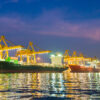

If the story of shipping’s first half were published as fiction, a critic might say: “Wildly inventive but highly implausible. Way too over-the-top. Too cluttered. Remember, less is more!”
And yet it’s all true.
Here’s a look back at the truth-is-stranger-than-fiction first six months on 2021, as recounted in American Shipper:
January
In this story, unlike Steven Soderbergh’s “Contagion” and other entries in the genre, the pandemic is great for business. There’s an unprecedented boom in shipping demand.
Americans’ rush to buy Asian-made sofas, bikes, appliances, flat-screen TVs, computers, etc. creates a colossal traffic jam of container ships in San Pedro Bay, where ships are stuck at anchor for weeks off the ports of Los Angeles and Long Beach (story here).
U.S. ports set new throughput records. Trans-Pacific spot rates are at all-time highs, hovering at around $4,200 per forty-foot equivalent unit to the West Coast and $5,800 per FEU to the East Coast.
The more that large ships race across the Pacific with more boxes stacked on their decks than ever before, the more accidents there are. Ships spill tens of millions of dollars’ worth of cargo into the ocean (story here).
There’s also action on Wall Street. There hasn’t been a shipping IPO here since Barack Obama was president, until now: Israeli container line operator ZIM goes public, pricing at $15 per share (story here).
It’s a busy month, but things are just getting started.
February
Another month of ships anchored as far as you can see in California’s San Pedro Bay. Trans-Pacific rates continue to hover at peak levels. Ports post another round of volume records. Even more containers fall off ships as they traverse the Pacific.
Investor interest in shipping — not just containers but also dry bulk and tankers — heats up (story here). ZIM (NYSE: ZIM) ends the month at $20 per share, 33% above its IPO price.
March
Major plot twist this month: The mega-container ship Ever Given gets stuck sideways in the Suez Canal.
It’s lodged there for six days, with over 350 ships waiting at anchor at the peak (story here). The world is transfixed.
Injecting some comic relief into the pandemic plotline, the Ever Given becomes a social-media meme (story here), unleashing a surreal wave of tweets and TikTok videos, including an Austin Powers parody, a dating app and a sea shanty.
On a serious note, already beleaguered shippers face weeks of delays for shipments to Europe and the East Coast as a result of the Ever Given accident (story here).
Congestion in Los Angeles/Long Beach moderately improves, with about 20 ships per day at anchor, but the crisis has already shattered the previous California congestion record set during labor unrest in 2015 (story here). And in what has become a familiar pattern, it’s yet another record month for ports (story here).
April-May
Freight rates resume their ascent in the wake of Ever Given-related disruptions to supply chains. Ship charter rates reach new highs as liners rush to add more tonnage to meet demand (story here).
The entire trans-Pacific fleet is effectively sold out for a month or more ahead. Cargo demand just keeps rising. A “tsunami of freight” is en route (story here).
Around 20 container ships remain at anchor off Los Angeles/Long Beach, with waiting time of about a week, but the bigger problem now is in Oakland. Waiting times there are up to three weeks (story here).
Amid supply chain chaos, ocean carriers report blockbuster first-quarter results (story here), pocketing more in the first three months of this year than in the entire previous year.
Freight rates rise rapidly and keep climbing, limited only by the profit margins of importers (story here). By the end of May, Asia-West Coast spot rates surge to $5,400, Asia-East Coast rates to $7,400 and ZIM’s stock to $46 — triple the IPO price.
June
The Suez Canal crisis offered excitement enough for an entire semester, but wait, there’s more:
The OOCL Durban crashes into a pier at the port of Kaohsiung, Taiwan. It destroys one gantry crane and seriously damages a second, limiting capacity at an important export facility (story here).

Simultaneously, China sharply restricts activity at the Port of Yantian in response to a COVID outbreak. Yantian and surrounding ports account for 25% of Chinese containerized exports to America. Over three weeks, carriers skip roughly 300 calls in Yantian. The fallout for U.S. imports is predicted to be much worse than fallout from the Ever Given (story here).
The hunt for shipping capacity becomes even more frantic. Retailer Home Depot takes the extraordinary step of securing its own ship (story here). Multiple charterers agree to pay owners over $100,000 per day (story here) for small container vessels — something that’s never happened before.
The pileup of container ships anchored and drifting off Oakland remains as bad as ever.
Trans-Pacific spot rates (excluding premium charges) rise faster this month than they have all year, reaching nearly $7,000 per FEU to the West Coast and over $10,000 per FEU to the East Coast — dramatically higher than January levels.
As for the Ever Given, its crew and its cargo, a deal is finally struck to release it from government detention (story here). Yet after all this time, the ship is still at anchor in Bitter Lake, Egypt.
Second half
Last year was unlike any other in shipping, as the industry grappled with the onset and fallout of COVID (story here). The first half of 2021 brought even more action. Things show no signs of calming down in the second half.
Despite record import volumes in the first half, retail inventory-to-sales ratios are still historically low. Goods consumption remains elevated despite vaccinated Americans spending more on services. The traditional peak season looms and importers face a rising risk of not getting goods on shelves by Christmas (story here).
There is no indication that spot rates or charter rates will fall materially before next year.
And as the second half begins, the Delta variant is sweeping across Asia (story here), meaning there could be even more supply chain disruptions ahead, akin to the Ever Given and Yantian incidents.


